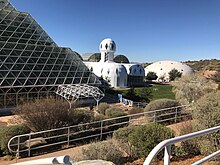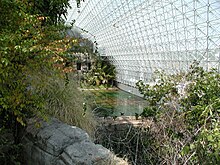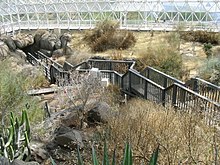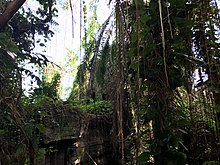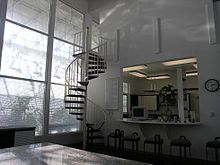From Wikipedia, the free encyclopedia
Biosphere 2 is an American
Earth system science research facility located in
Oracle, Arizona. It has been owned by the
University of Arizona since 2011. Its mission is to serve as a center for research, outreach, teaching, and
lifelong learning about Earth, its living systems, and its place in the universe. It is a 3.14-acre (1.27-hectare) structure originally built to be an
artificial, materially closed ecological system, or
vivarium. It remains the largest closed system ever created.
Biosphere 2 was originally meant to demonstrate the viability of
closed ecological systems to support and maintain human life in outer
space.
It was designed to explore the web of interactions within life systems
in a structure with different areas based on various biological
biomes.
In addition to the several biomes and living quarters for people,
there was an agricultural area and work space to study the interactions
between humans, farming, technology and the rest of nature as a new kind
of laboratory for the study of the global ecology. Its mission was a
two-year closure experiment with a crew of eight humans
("biospherians"). Long-term it was seen as a precursor to gain knowledge about the use of closed biospheres in
space colonization.
As an experimental ecological facility it allowed the study and
manipulation of a mini biospheric system without harming Earth's
biosphere. Its seven biome areas were a 1,900-square-meter
(20,000 sq ft)
rainforest, an 850-square-meter (9,100 sq ft)
ocean with a
coral reef, a 450-square-meter (4,800 sq ft)
mangrove wetlands, a 1,300-square-metre (14,000 sq ft)
savannah grassland, a 1,400-square-meter (15,000 sq ft)
fog desert, and two anthropogenic biomes: a 2,500-square-meter (27,000 sq ft)
agricultural system and a human
habitat
with living spaces, laboratories and workshops. Below ground was an
extensive part of the technical infrastructure. Heating and cooling
water circulated through independent piping systems and
passive solar input through the glass
space frame panels covering most of the facility, and
electrical power was supplied into Biosphere 2 from an onsite natural gas energy center.
Biosphere 2 was only used twice for its original intended
purposes as a closed-system experiment: once from 1991 to 1993, and the
second time from March to September 1994. Both attempts, though heavily
publicized, ran into problems including low amounts of food and oxygen,
die-offs of many animals and plants included in the experiment (though
this was anticipated since the project used a strategy of deliberately
"species-packing" anticipating losses as the biomes developed), group
dynamic tensions among the resident crew, outside politics and a power
struggle over management and direction of the project. Nevertheless, the
closure experiments set world records in closed ecological systems,
agricultural production, health improvements with the high nutrient and
low caloric diet the crew followed, and insights into the
self-organization of complex biomic systems and atmospheric dynamics. The second closure experiment achieved total food sufficiency and did not require injection of oxygen.
In June 1994, during the middle of the second experiment, the
managing company, Space Biosphere Ventures, was dissolved, and the
facility was left in limbo. Columbia University assumed management of
the facility in 1995 and used it to run experiments until 2003. It then
looked in danger of being demolished to make way for housing and retail
stores, but was taken over for research by the University of Arizona in
2007. The University of Arizona took full ownership of the structure in
2011.
Planning and construction
Biosphere
2 was originally constructed between 1987 and 1991 by Space Biosphere
Ventures, a joint venture whose principal officers were
John P. Allen,
inventor and executive chairman; Margaret Augustine, CEO; Marie
Harding, vice-president of finance; Abigail Alling, vice president of
research; Mark Nelson, director of space and environmental applications,
William F. Dempster, director of system engineering, and Norberto
Alvarez-Romo, vice president of mission control. Project funding came
primarily from the joint venture's financial partner,
Ed Bass's Decisions Investment. The project cost US$200 million from 1985 to 2007.
It was named "Biosphere 2" because it was meant to be the second fully self-sufficient
biosphere, after the Earth itself.
Location
Biosphere 2 sits on a sprawling 40-acre (16-hectare) science campus that is open to the public
Exterior showing parts of the rainforest biome and of the habitat, with the West lung in the background.
Engineering
Biosphere 2, view from the thornscrub, a transition zone between Savannah and Desert (foreground) and Ocean (background) sections.
The tropical rainforest biome in February, 2017
The above-ground physical structure of Biosphere 2 was made of steel
tubing and high-performance glass and steel frames. The frame and
glazing materials were designed and made to specification by a firm run
by a one-time associate of
Buckminster Fuller, Peter Jon Pearce (Pearce Structures, Inc.).
The window seals and structures had to be designed to be almost
perfectly airtight, such that the air exchange would be extremely low,
permitting tracking of subtle changes over time. The patented airtight
sealing methods, developed by Pearce and William Dempster, achieved a
remarkable leak rate of less than 10% per year. Without such tight
closure, the slow decline of oxygen which occurred at a rate of less
than 1/4% per month during the first two-year closure experiment might
not have been observed.
During the day, the heat from the sun caused the air inside to
expand and during the night it cooled and contracted. To avoid having to
deal with the huge forces that maintaining a constant volume would
create, the structure had large diaphragms kept in domes called "lungs"
or variable volume structures.
Since opening a window was not an option, the structure also
required a sophisticated system to regulate temperatures within desired
parameters, which varied for the different biomic areas. Though cooling
was the largest energy need, heating had to be supplied in the winter
and closed loop pipes and air handlers were key parts of the energy
system. An energy center on site provided electricity and heated and
cooled water, employing natural gas and backup generators, ammonia
chillers and water cooling towers.
First mission
The first closed mission lasted from September 26, 1991 to September 26, 1993. The crew were: medical doctor and researcher
Roy Walford,
Jane Poynter,
Taber MacCallum,
Mark Nelson, Sally Silverstone, Abigail Alling, Mark Van Thillo, and Linda Leigh.
The agricultural system produced 83% of the total diet, which
included crops of bananas, papayas, sweet potatoes, beets, peanuts,
lablab and
cowpea beans, rice, and wheat.
No toxic chemicals could be used, since they would impact health and
water and nutrients were recycled back into the farm soils. Especially
during the first year the eight inhabitants reported continual hunger.
Calculations indicated that Biosphere 2's farm was amongst the highest
producing in the world "exceeding by more than five times that of the
most efficient agrarian communities of Indonesia, southern China, and
Bangladesh.”
They consumed the same low-calorie, nutrient-dense diet which Roy Walford had studied in his research on
extending lifespan through diet.
Medical markers indicated the health of the crew during the two years
was excellent. They showed the same improvement in health indices such
as lowering of blood cholesterol, blood pressure, enhancement of immune
system. They lost an average of 16% of their pre-entry body weight
before stabilizing and regaining some weight during their second year. Subsequent studies showed that the biospherians'
metabolism became more efficient at extracting nutrients from their food as an adaptation to the low-calorie, high nutrient diet.
"The overall health of the biospherians crews inside Biosphere 2
confirm that the original design of the Biosphere 2 technosphere systems
did avoid a buildup of toxins, and the bioregenerative technologies and
life systems inside Biosphere 2 maintained a healthy environment."
Some of the domestic animals that were included in the agricultural area during the first mission included four African
pygmy goats and one billy goat, 35 hens and three roosters (a mix of Indian jungle fowl (
Gallus gallus),
Japanese silky bantam, and a hybrid of these), two sows and one boar Ossabaw dwarf pigs, as well as
tilapia fish grown in a rice and
azolla pond system originating millennia ago in China.
A strategy of "species-packing" was practiced to ensure that food
webs and ecological function could be maintained if some species did
not survive. The
fog desert area became more
chaparral
in character due to condensation from the space frame. The savannah was
seasonally active; its biomass was cut and stored by the crew as part
of their management of carbon dioxide. Rainforest
pioneer species grew rapidly, but trees there and in the savannah suffered from
etiolation and weakness caused by lack of
stress wood, normally created in response to winds in natural conditions.
Corals
reproduced in the ocean area, and crew helped maintain ocean system
health by hand-harvesting algae from the corals, manipulating calcium
carbonate and pH levels to prevent the ocean becoming too acidic, and by
installing an improved
protein skimmer to supplement the algae turf
scrubber system originally installed to remove excess nutrients. The mangrove area developed rapidly but with less
understory than a typical
wetland possibly because of reduced light levels.
Nevertheless, it was judged to be a successful analogue to the
Everglades area of Florida where the mangroves and marsh plants were
collected.
Biosphere 2 because of its small size and buffers, concentration
of organic materials and life, had greater fluctuations and more rapid
biogeochemical cycles than are found in Earth's biosphere. Most of the introduced
vertebrate species and virtually all of the
pollinating insects died, though there was reproduction of plants and animals. Insect pests, like
cockroaches, flourished. Many insects had been included in original species mixes in the biomes but a globally invasive tramp ant species,
Paratrechina longicornis, unintentionally sealed in, had come to dominate other ant species.
The planned ecological succession in the rainforest and strategies to
protect the area from harsh incident sunlight and salt aerosols from the
ocean worked well, and a surprising amount of the original biodiversity
persisted. Biosphere 2 in its early ecological development was likened to an island ecology.
Group dynamics: psychology, conflict, and cooperation
View of part of the crew dining room, serving counter from kitchen and stairway up to an entertainment area.
The crew's kitchen as it originally looked during the first mission.
Much of the evidence for isolated human groups comes from psychological studies of scientists overwintering in
Antarctic research stations. The study of this phenomenon is "confined environment psychology", and according to Jane Poynter it was known to be a challenge and often crews split into factions.
Before the first closure mission was half over, the group had
split into two factions and, according to Poynter, people who had been
intimate friends had become implacable enemies, barely on speaking
terms.
Others point out that the crew continued to work together as a team to
achieve the experiment's goals, mindful that any action that harmed
Biosphere 2 might imperil their own health. This is in contrast to other
expeditions where internal frictions can lead to unconscious sabotage
of each other and the overall mission. All of the crew felt a very
strong and visceral bond with their living world.
They kept air and water quality, atmospheric dynamics and health of the
life systems constantly in their attention in a very visceral and
profound way. This intimate “metabolic connection” enabled the crew to
discern and respond to even subtle changes in the living systems.
(Alling et al., 2002; Alling and Nelson, 1993). "Appreciation of the
value of biosphere interconnectedness and interdependency was
appreciated as both an everyday beauty and a challenging reality",
Walford later acknowledged "I don't like some of them, but we were a
hell of a team. That was the nature of the factionalism... but despite
that, we ran the damn thing and we cooperated totally".
The factions inside the bubble formed from a rift and power
struggle between the joint venture partners on how the science should
proceed, as biospherics or as specialist ecosystem studies (perceived as
reductionist). The faction that included Poynter felt strongly that
increasing research should be prioritized over degree of closure. The
other faction backed project management and the overall mission
objectives. On February 14, a portion of the Scientific Advisory
Committee (SAC) resigned.
Time Magazine
wrote: "Now, the veneer of credibility, already bruised by allegations
of tamper-prone data, secret food caches and smuggled supplies, has
cracked ... the two-year experiment in self-sufficiency is starting to
look less like science and more like a $150 million stunt".
In fact, the SAC was dissolved because it had deviated from its mandate
to review and improve scientific research and became involved in
advocating management changes. A majority of the SAC members chose to
remain as consultants to Biosphere 2. The SAC's recommendations in their
report were implemented including a new Director of Research [Dr. Jack
Corliss], allowing import/export of scientific samples and equipment
through the facility airlocks to increase research and decrease crew
labor, and to generate a formal research program. Some sixty-four
projects were included in the research program that Walford and Alling
spearheaded developing.
Undoubtedly the lack of oxygen and the calorie-restricted, nutrient-dense diet contributed to low morale.
The Alling faction feared that the Poynter group were prepared to go so
far as to import food, if it meant making them fitter to carry out
research projects. They considered that would be a project failure by
definition.
In November 1992, the hungry Biospherians began eating seed stocks that had not been grown inside the Biosphere 2. Poynter made Chris Helms,
PR
Director for the enterprise, aware of this. She was promptly dismissed
by Margret Augustine, CEO of Space Biospheres Ventures, and told to come
out of the biosphere. This order was, however, never carried out.
Poynter writes
that she simply decided to stay put, correctly reasoning that the order
could not be enforced without effectively terminating the closure.
Isolated groups tend to attach greater significance to group
dynamic and personal emotional fluctuations common in all groups. Some
reports from polar station crews exaggerated psychological problems.
So, although some of the first closure team thought they were
depressed, psychological examination of the biospherians showed no
depression and fit the explorer/adventurer profile, with both women and
men testing very similar to astronauts.
One of the psychologists noted, "If I was lost in the Amazon and was
looking for a guide to get out, and to survive with, then [the
biospherian crew] would be top choices."
Challenges
Among
the problems and miscalculations encountered in the first mission were
unanticipated condensation making the "desert" too wet, population
explosions of greenhouse ants and cockroaches, morning glories
overgrowing the rainforest area, blocking out other plants and less
sunlight (40-50% of outside light) entering the facility than originally
anticipated. Biospherians intervened to control invasive plants when
needed to preserve biodiversity, functioning as "
keystone predators".
In addition, construction itself was a challenge; for example, it was
difficult to manipulate the bodies of water to have waves and tidal
changes.
Engineers came up with innovative solutions to supplement natural
functions the Earth's biosphere normally performs, e.g. vacuum pumps to
create gentle waves in the ocean without endangering marine biota,
sophisticated heating and cooling systems. All the technology was
selected to minimize outgassing and discharge of harmful substances
which might damage Biosphere 2's life.
There was controversy when the public learned that the project
had allowed an injured member to leave and return, carrying new material
inside. The team claimed the only new supplies brought in were plastic
bags, but others accused them of bringing food and other items. More
criticism was raised when it was learned that, likewise, the project
injected oxygen in January 1993 to make up for a failure in the balance
of the system that resulted in the amount of oxygen steadily declining.
Some thought that these criticisms ignored that Biosphere 2 was an
experiment where the unexpected would occur, adding to knowledge of how
complex ecologies develop and interact, not a demonstration where
everything was known in advance.
H.T. Odum noted: “The management process during 1992-1993 using data to
develop theory, test it with simulation, and apply corrective actions
was in the best scientific tradition. Yet some journalists crucified the
management in the public press, treating the project as if it was an
Olympic contest to see how much could be done without opening the
doors”.
The
oxygen
inside the facility, which began at 20.9%, fell at a steady pace and
after 16 months was down to 14.5%. This is equivalent to the oxygen
availability at an elevation of 4,080 meters (13,400 ft). Since some biospherians were starting to have
symptoms like
sleep apnea
and fatigue, Walford and the medical team decided to boost oxygen with
injections in January and August 1993. The oxygen decline and minimal
response of the crew indicated that changes in air pressure are what
trigger human adaptation responses. These studies enhanced the
biomedical research program.
Managing CO
2 levels was a particular challenge, and a
source of controversy regarding the Biosphere 2 project's alleged
misrepresentation to the public. Daily fluctuation of
carbon dioxide dynamics was typically 600 ppm because of the strong drawdown during sunlight hours by plant
photosynthesis, followed by a similar rise during the nighttime when system
respiration dominated. As expected, there was also a strong seasonal signature to CO
2
levels, with wintertime levels as high as 4,000-4,500 ppm and
summertime levels near 1,000 ppm. The crew worked to manage the CO
2 by occasionally turning on a
CO2 scrubber,
activating and de-activating the desert and savannah through control of
irrigation water, cutting and storing biomass to sequester carbon, and
utilizing all potential planting areas with fast-growing species to
increase system photosynthesis. In November 1991, investigative reporting in the
Village Voice alleged that the crew had secretly installed the CO
2 scrubber device, and claimed that this violated Biosphere 2's advertised goal of recycling all materials naturally.
Others pointed out there was nothing secret about the carbon dioxide
device and it constituted another technical system augmenting ecological
processes. The carbon precipitator could reverse the chemical reactions
and thus release the stored carbon dioxide in later years when the
facility might need additional carbon.
Many suspected the drop in oxygen was due to
microbes in the soil.
The soils were selected to have enough carbon to provide for the plants
of the ecosystems to grow from infancy to maturity, a plant mass
increase of perhaps 20 tons (18,000 kg).
The release rate of that soil carbon as carbon dioxide by respiration
of soil microbes was an unknown that the Biosphere 2 experiment was
designed to reveal. Subsequent research showed that Biosphere 2's farm
soils had reached a more stable ratio of carbon and nitrogen, lowering
the rate of CO
2 release, by 1998.
The respiration rate was faster than the photosynthesis (possibly
in part due to relatively low light penetration through the glazed
structure and the fact that Biosphere 2 started with a small but rapidly
increasing plant biomass) resulting in a slow decrease of oxygen. A
mystery accompanied the oxygen decline: the corresponding increase in
carbon dioxide did not appear. This concealed the underlying process
until an investigation by Jeff Severinghaus and
Wallace Broecker of Columbia University's
Lamont Doherty Earth Observatory using isotopic analysis showed that carbon dioxide was reacting with exposed concrete inside Biosphere 2 to form
calcium carbonate, thereby sequestering both carbon and oxygen.
Second mission
During
the transition period between missions, extensive research and system
improvements had been undertaken. Concrete was sealed to prevent uptake
of carbon dioxide. The second mission began on March 6, 1994, with an
announced run of ten months. The crew was Norberto Alvarez-Romo (Capt.),
John Druitt, Matt Finn, Pascale Maslin, Charlotte Godfrey, Rodrigo Romo
and Tilak Mahato. The second crew achieved complete sufficiency in food
production.
On April 1, 1994 a severe dispute within the management team led to the ousting of the on-site management by
federal marshals serving a restraining order, and financier
Ed Bass hired
Stephen Bannon, manager of the
Bannon & Co. investment banking team from Beverly Hills, California, to run Space Biospheres Ventures.
Some biospherians and staff were concerned about Bannon, who had
previously investigated cost overruns at the site. Two former Biosphere 2
crew members flew back to Arizona to protest the hire and broke into
the compound to warn current crew members that Bannon and the new
management would jeopardize their safety.
At 3 am on April 5, 1994, Abigail Alling and Mark Van Thillo,
members of the first crew, allegedly vandalized the project from
outside,
opening one double-airlock door and three single door emergency exits,
leaving them open for approximately fifteen minutes. Five panes of
glass were also broken. Alling later told the
Chicago Tribune that she "considered the Biosphere to be in an emergency state... In no way was it sabotage. It was my responsibility." About 10% of the biosphere's air was exchanged with the outside during this time, according to systems analyst
Donella Meadows,
who received a communication from Ms. Alling in which she explained
that she and Van Thillo judged it their ethical duty to give those
inside the choice of continuing with the drastically changed human
experiment or leaving, as they didn't know what the crew had been told
of the new situation. “On April 1, 1994, at approximately 10 AM …
limousines arrived on the biosphere site … with two investment bankers
hired by Mr. Bass … They arrived with a temporary restraining order to
take over direct control of the project … With them were 6-8 police
officers hired by the Bass organization … They immediately changed locks
on the offices … All communication systems were changed (telephone and
access codes), and [we] were prevented from receiving any data regarding
safety, operations, and research of Biosphere 2.” Alling emphasized
several times in her letter that the “bankers” who suddenly took over
“knew nothing technically or scientifically, and little about the
biospherian crew.”
Four days later, the captain Norberto Alvarez-Romo (by then
married to Biosphere 2 chief executive Margaret Augustine) precipitously
left the Biosphere for a "family emergency" after his wife's
suspension.
He was replaced by Bernd Zabel, who had been nominated as captain of
the first mission but who was replaced at the last minute. Two months
later, Matt Smith replaced Matt Finn.
The ownership and management company Space Biospheres Ventures
was officially dissolved on June 1, 1994. This left the scientific and
business management of the mission to the interim turnaround team, who
had been contracted by the financial partner, Decisions Investment Co.
Mission 2 was ended prematurely on September 6, 1994. No further
total system science has emerged from Biosphere 2 as the facility was
changed by Columbia University from a closed ecological system to a
"flow-through" system where CO2 could be manipulated at desired levels.
Steve Bannon
left Biosphere 2 after two years, but his departure was marked by a
civil lawsuit filed against Space Biosphere Ventures by the former crew
members who had broken in.
During a 1996 trial, Bannon testified that he had called one of the
plaintiffs, Abigail Alling, a "self-centered, deluded young woman" and a
"bimbo."
He also testified that when the woman submitted a five-page complaint
outlining safety problems at the site, he promised to shove the
complaint "down her fucking throat." Bannon attributed this to "hard
feelings and broken dreams."
At the end of the trial, the jury found for the plaintiffs and ordered
Space Biosphere Ventures to pay them $600,000, but also ordered the
plaintiffs to pay the company $40,089 for the damage they had caused. Some
have observed that Bannon orchestrated the hostile take-over and
destruction of Biosphere 2 as a revolutionary total system global
ecology laboratory, not because of any interest in ecological science.
Science
A
special issue of the Ecological Engineering journal edited by Marino and
Howard T. Odum (1999), published as "Biosphere 2: Research Past and
Present" (Elsevier, 1999) represents the most comprehensive assemblage
of collected papers and findings from Biosphere 2. The papers range from
calibrated models that describe the system metabolism, hydrologic
balance, and heat and humidity, to papers that describe rainforest,
mangrove, ocean, and agronomic system development in this carbon
dioxide-rich environment.
Though several dissertations and many scientific papers used data from
the early closure experiments at Biosphere 2, much of the original data
has never been analyzed and is unavailable or lost, perhaps due to
scientific politics and in-fighting.
Some of the controversy at Biosphere 2 stemmed from the
long-standing division in science between analytic, reductionist science
and integrative, holistic science.
Rebecca Reider expanded her history of science thesis at Harvard
into a book on Biosphere 2. She noted that because Biosphere 2's
creators were perceived as outsiders to academic science, the project
was scrutinized but sometimes poorly understood in the media. She noted
that Biosphere 2 broke a number of unspoken taboos: “’Science’ could be
performed only by official scientists, only the right high priests could
interpret nature for everyone else….’Science’ was separate from art
(and the thinking mind was separate from the emotional heart)…’Science’
required some neat intellectual boundary between humans and nature; it
did not necessarily involve humans learning to live with the world
around them. Finally, ‘science’ must follow a specific method: think up a
hypothesis, test it and get some numbers to prove you were right”.
After Columbia University assumed management, the scrutiny ceased
because it was assumed they were "proper" scientists.
The dichotomy is a false one as there are many valid approaches
to science. John Allen, the inventor of Biosphere 2, wrote: “Four basic
ways uneasily co-exist in science to deal with understanding complex
systems: [1] prolonged naturalist observation, description of observed
regularities and classification of parts… [2] analyzing component parts
of the object of study, formulating restricted hypotheses, and then,
holding all else other than the chosen part as constant as possible,
measure changes produced by measured impacts...[3] accept complexity as
an irreducible element, and then to search for the organized structure
that enables us to examine the entity as a whole, to ascertain its
specific laws or regularities…[4] Put into an operating model a
synthesis of these three approaches, together with test principles of
engineering, to test the validity of the existent thinking’s predictive
powers, and to provide a fecund base for new observations. This full
interplay of observation, analysis and structuring to make a working
apparatus in order to test and extend our knowledge of biospherics is
the approach we used to create Biosphere 2. This interplay of all four
scientific approaches is required to study Earth’s biosphere, the most
complex entity yet encountered.”
Praise and criticism
One view of Biosphere 2 was that it was "the most exciting scientific project to be undertaken in the U.S. since President
John F. Kennedy launched us toward the moon". Others called it "
New Age drivel masquerading as science". John Allen and Roy Walford did have mainstream credentials.
John Allen
held a degree in Metallurgical-Mining Engineering from the Colorado
School of Mines, and an MBA from the Harvard Business School.
Roy Walford received his doctorate of medicine from the University of
Chicago and taught at UCLA as a Professor of Pathology for 35 years.
Mark Nelson obtained his Ph.D. in 1998 under Professor
H.T. Odum in ecological engineering further developing the constructed wetlands used to treat and recycle sewage in Biosphere 2, to coral reef protection along the Yucatán coast where the corals were collected. Linda Leigh obtained her PhD with a dissertation on biodiversity and the Biosphere 2 rainforest working with Odum.
Abigail Alling, Mark van Thillo and Sally Silverstone helped start the
Biosphere Foundation where they worked on coral reef and marine
conservation and sustainable agricultural systems.
Jane Poynter and Taber MacCallum co-founded Paragon Space Development
Corporation which has studied the first mini-closed system and the first
full animal life cycle in space and assisted in setting world records
in high altitude descents.
Questioning the credentials of the participants (despite the
contribution in the preparation phase of Biosphere 2 of worldwide
top-level scientists and among others the
Russian Academy of Sciences),
Marc Cooper wrote that "the group that built, conceived, and directs
the Biosphere project is not a group of high-tech researchers on the
cutting edge of science but a clique of recycled theater performers that
evolved out of an authoritarian—and decidedly
non-scientific—personality cult". He was referring to the
Synergia Ranch in
New Mexico,
where indeed many of the Biospherians did practice theater under John
Allen's leadership, and began to develop the ideas behind Biosphere 2. They also founded the Institute of Ecotechnics
and began innovative field projects in challenging biomes to advance
the healthy integration of human technologies and the environment where
many of the biospherian candidates gained experience in operating
real-time complex projects.
One of their own scientific consultants was earlier critical. Dr.
Ghillean Prance, director of the
Royal Botanical Gardens in
Kew, designed the rainforest
biome
inside the Biosphere. Although he later changed his opinion,
acknowledging the unique scope of this experiment and contributed to its
success as a consultant, in a 1983 interview (8 years before the start
of the experiment), Prance said, "I was attracted to the
Institute of Ecotechnics
because funds for research were being cut and the institute seemed to
have a lot of money which it was willing to spend freely. Along with
others, I was ill-used. Their interest in science is not genuine. They
seem to have some sort of secret agenda, they seem to be guided by some
sort of religious or philosophical system." Prance went on in the 1991
newspaper interview to say "they are visionaries.,.And maybe to fulfill
their vision they have become somewhat cultlike. But they are not a
cult, per se....I am interested in ecological restoration systems. And I
think all sorts of scientific things can come of this experiment, far
beyond the space goal... When they came to me with this new project,
they seemed so well organized, so inspired, I simply decided to forget
the past. You shouldn't hold their past against them."
Poynter in her memoir rebuts the critique that because some of
the creative team of Biosphere 2 weren't highly credentialed scientists,
that that ad hominem argument invalidates the results of the endeavor.
"“Some reporters hurled accusations that we were unscientific.
Apparently because many of the SBV managers were not themselves degreed
scientists, this called into question the entire validity of the
project, even though some of the world’s best scientists were working
vigorously on the project’s design and operation. The critique was not
fair. Since leaving Biosphere 2, I have run a small business for ten
years that sent experiments on the shuttle and to the space station, and
is designing life support systems for the replacement shuttle and
future moon base. I do not have a degree, not even an MBA from Harvard,
as John [Allen] had. I hire scientists and top engineers. Our company’s
credibility is not called into question because of my credentials: we
are judged on the quality of our work”.
H.T. Odum noted that mavericks, outsiders have often contributed to the
development of science: “The original management of Biosphere 2 was
regarded by many scientists as untrained for lack of scientific degrees,
even though they had engaged in a preparatory study program for a
decade, interacting with the international community of scientists
including the Russians involved with closed systems. The history of
science has many examples where people of atypical background open
science in new directions, in this case implementing mesocosm
organization and ecological engineering with fresh hypotheses”.
The Biosphere 2 Science Advisory Committee, chaired by Tom
Lovejoy of the Smithsonian Institution, in its report of August 1992
reported: "The committee is in agreement that the conception and
construction of Biosphere 2 were acts of vision and courage. The scale
of Biosphere 2 is unique and Biosphere 2 is already providing unexpected
scientific results not possible through other means (notably the
documented, unexpected decline in atmospheric oxygen levels.) Biosphere 2
will make important scientific contributions in the fields of
biogeochemical cycling, the ecology of closed ecological systems, and
restoration ecology." Columbia University assembled outside scientists
to evaluate the potential of the facility after they took over
management, and concluded the following: "A group of world-class
scientists got together and decided the Biosphere 2 facility is an
exceptional laboratory for addressing critical questions relative to the
future of Earth and its environment."
Columbia University
In December 1995 the Biosphere 2 owners transferred management to
Columbia University of New York City which embarked on a successful eight-year run at the Biosphere 2 campus. Columbia ran Biosphere 2 as a research site and campus until 2003. Subsequently, management reverted to the owners.
In 1996, Columbia University changed the virtually airtight,
materially closed structure designed for closed system research, to a
"flow-through" system, and halted closed system research. They
manipulated carbon dioxide levels for
global warming research, and injected desired amounts of carbon dioxide, venting as needed.
During Columbia's tenure, students from Columbia and other colleges and
universities would often spend one semester at the site.
Important research during Columbia's tenure demonstrated the
devastating impacts on coral reefs from elevated atmospheric CO2 and
acidification that will result from continued global climate change.
Frank Press, former president of the National Academy of Sciences,
described these interactions between atmosphere and ocean, taking
advantage of the highly controllable ocean mesocosm of Biosphere 2, as
the “first unequivocal experimental confirmation of the human impact on
the planet”.
Studies in Biosphere 2’s terrestrial biomes showed that a
saturation point was reached with elevated CO2 beyond which they are
unable to uptake more. The studies' authors noted that the striking
differences between the Biosphere 2 rainforest and desert biomes in
their whole system responses “illustrates the importance of large-scale
experimental research in the study of complex global change issues".
Site sold
In
January 2005, Decisions Investments Corporation, owner of Biosphere 2,
announced that the project's 1,600-acre (650 ha) campus was for sale.
They preferred a research use to be found for the complex but were not
excluding buyers with different intentions, such as big universities,
churches, resorts, and spas.
In June 2007 the site was sold for $50 million to CDO Ranching &
Development, L.P. 1,500 houses and a resort hotel were planned, but the
main structure was still to be available for research and educational
use.
Acquisition by University of Arizona
On June 26, 2007, the
University of Arizona
announced it would take over research at the Biosphere 2. The
announcement ended fears that the structure would be demolished.
University officials said private gifts and grants enabled them to cover
research and operating costs for three years with the possibility of
extending funding for ten years.
It was extended for ten years, and is now engaged in research projects
including research into the terrestrial water cycle and how it relates
to ecology, atmospheric science, soil geochemistry, and climate change.
In June 2011, the university announced that it would assume full
ownership of Biosphere 2, effective July 1.
CDO Ranching & Development donated the land, Biosphere buildings
and several other support and administrative buildings. The Philecology
Foundation (a nonprofit research foundation founded by Ed Bass) pledged
US$20 million for the ongoing science and operations.
Current research
There are many small-scale research projects at Biosphere 2, as well as several large-scale research projects including:







